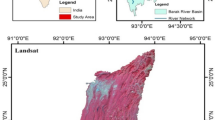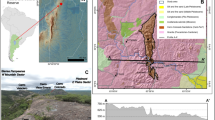Abstract
A digital terrain model and a 3D fly-through model of the Nigde province in central Anatolia, Turkey were generated and quantitatively analyzed employing the shuttle radar topographic mission (SRTM) digital elevation model (DEM). Besides, stream drainage patterns, lineaments and structural–geological features were extracted and analyzed. In the process of analyzing and interpreting the DEM for landforms, criteria such as color and color tones (attributes of heights), topography (shaded DEM and 3D fly-through model) and stream drainage patterns were employed to acquire geo-information about the land, such as hydrologic, geomorphologic, topographic and tectonic structures. In this study, the SRTM DEM data of the study region were experimentally used for both DEM classification and quantitative analysis of the digital terrain model. The results of the DEM classification are: (1) low plain including the plains of Bor and Altunhisar (20.7%); (2) high plain including the Misli (Konakli) plain (28.8%); (3) plateau plain including the Melendiz (Ciftlik) plateau plain (1.0%); (4) mountain including the Nigde massif (33.3%); and (5) high mountain (16.2%). High mountain areas include a caldera complex of Mt Melendiz, Mt Hasan and Mt Pozanti apart from the Ala mountains called Aladaglar and the Bolkar mountains called Bolkarlar in the study region (7,312km2). Analysis of both the stream drainage patterns and the lineaments revealed that the Nigde province has a valley zone called Karasu valley zone (KVZ) or Nigde valley zone (NVZ), where settlements and agricultural plains, particularly the Bor plain in addition to settlements of the Bor town and the central city of Nigde have the most flooding risk when a heavy raining occurs. The study revealed that the NVZ diagonally divides the study region roughly into two equal parts, heading from northeast to southwest. According to the map created in this study, the right side of the NVZ has more mountainous area, where the Aladaglar is a wildlife national park consisting of many species of fauna and flora whereas the left side of the NVZ has more agricultural plain, with exception of a caldera complex of Mt Melendiz and volcanic Mt Hasan. The south of the study region includes the Bolkarlar. In addition, the Ecemis fault zone (EFZ) lying along the Ecemis rivulet, running from north to south at the west side of the Aladaglar, forms the most important and sensitive location in the region in terms of the tectonics.






Similar content being viewed by others
References
ArcGIS 9.0 Manual (2007) ESRI, 380 New York Street, Redlands. http://www.esri.com/
Argialas DP, Lyon JG (1988) Quantitative description and classification of drainage patterns. Photogramm Eng Remote Sens 54(4):505–509
Band LE (1986) Topographic partition of watersheds with digital elevation models. Water Resour Res 22(1):l5–24
Cemen I, Goncuoglu MC, Dirik K (1999) Structural evalution of the Tuzgolu basin in central Anatolia, Turkey. J Geol 107:693–706
Dhont D, Chorowicz J, Yurur T, Froger J-L, Kose O, Gundogdu N (1998) Emplacement of volcanic vents and geodynamics of central Anatolia, Turkey. J Volcanol Geotherm Res 85:33–54
Drury SA (2001) Image interpretation in geology. Blackwell, London
Eastman R (2006) Idrisi Andes manual and tutorial. Clark Labs, Clark University, Worchester
El Sheimy N, Valeo C, Habib A (2005) Digital terrain modeling: acquisition, manipulation and applications. Artech House, Boston
Farr TG, Rosen PA, Caro E, Crippen R, Duren R, et al. (2007) The shuttle radar topography mission. Rev Geophys 45. doi:10.1029/2005RG000183
Florinsky IV (1998) Combined analysis of digital terrain models and remotely sensed data in landscape investigations. Prog Phys Geogr 22(1):33–60
Froger J-L, Lenat J-F, Chorowicz J, Le Pennec J-L, Bourdier J-L, Kose O, Zimitoglu O, Gundogdu NM, Gourgaud A (1998) Hidden calderas evidenced by multisource geophysical data; example of Cappadocian calderas, central Anatolia. J Volcanol Geotherm Res 185:99–128
Goze K, Altin BN, Gedik I, Atabey H, Ozmel I, Oncu A, Ertana T (1997) Nigde. Nigde Governorship, Turkey
Gorokhovich Y, Voustianiouk A (2006) Accuracy assessment of the processed SRTM-based elevation data by CGIAR using field data from USA and Thailand and its relation to the terrain characteristics. Remote Sens Environ 104:409–415
Idrisi Andes 15.0 Manual (2007) Clark labs, Clark University, Worcester. http://www.clarklabs.org/
Jaffey N, Robertson AHF (2001) New sedimentological and structural data from the Ecemis fault zone, southern Turkey: implications for its timing and offset and the Cenozoic tectonic escape of Anatolia. J Geol Soc London 158:367–378
Jordan G (2003) Morphometric analysis and tectonic interpretation of digital terrain data: a case study. Earth Surf Process Landf 28:807–822
Jordan G, Schott B (2005) Application of wavelet analysis to the study of spatial pattern of morphotectonic lineaments in digital terrain models. A case study. Remote Sens Environ 94:31–38
Koc MO, Kilinc E, Tecimer I, Kayacilar C (2007) Nigde. Nigde Governorship, Turkey
Kocyigit A, Beyhan A (1998) A new intracontinental transcurrent structure: the central Anatolian fault zone, Turkey. Tectonophysics 284:317–336
Konecny G (2002) Geoinformation: remote sensing, photogrammetry and geographical information systems. Taylor & Francis, London
Le Pennec J-L, Bourdier J-L, Froger J-L, Temel A, Camus G, Gourgaud A (1994) Neogene ignimbrites of the Nevsehir plateau (central Turkey); stratigraphy, distribution and source constraints. J Volcanol Geotherm Res 63:58–87
Mark DM, Dozier J, Frew J (1984) Automated basin delineation from digital elevation data. Geo Process 2:299–311
Nigde Governorship (2007) Nigde. Nigde Governorship, Turkey http://www.nigde.gov.tr/
O’Callaghan JF, Mark DM (1984) The extraction of drainage networks from digital elevation data. Comput Vis Graph Image Process 28:328–344
Pandey SN (1987) Principles and applications of photogeology. Wiley, New York
Prost GL (1994) Remote sensing for geologists: a guide to image interpretation. Taylor & Francis, London
Ray RG (1960) Aerial photographs in geologic interpretation and mapping. United States Geological Survey, Washington
Siegal BS, Gillespie AR (1980) Remote sensing in geology. Wiley, New York
Sun G, Ranson KJ, Kharuk VI, Kovacs K (2003) Validation of surface height from shuttle radar topography mission using shuttle laser altimeter. Remote Sens Environ 88:401–411
Topal T, Doyuran V (1998) Analyses of deterioration of the Cappadocian tuff, Turkey. Environ Geol 34(1):5–20
Toprak V (1998) Vent distribution and its relation to regional tectonics, Cappadocian volcanics, Turkey. J Volcanol Geotherm Res 85:55–67
Toprak V, Goncuoglu MC (1993a) Tectonic control on the development of Neogene-Quaternary Central Anatolian Volcanic Province, Turkey. Geol J 28:357–369
Toprak V, Goncuoglu MC (1993b) Keceboyduran–Melendiz fault and its regional significance (central Anatolia). Yerbilimleri 16:55–65, in Turkish with English abtract
Westaway R (1999) Comment on “A new intracontinental transcurrent structure: the central Anatolian fault zone, Turkey” by Kocyigit and Beyhan. Tectonophysics 314:469–479
Whitney DL, Dilek Y (1997) Core complex development in central Anatolia, Turkey. Geology 25:1023–1026
Wilson JP, Gallant JC (2000) Terrain analysis: principles and applications. Wiley, New York
Yetis C (1978) Geology of the Camardi (Nigde) region and characteristics of the Ecemis Fault Zone between Maden Bogazi and Kamisli. Istanbul University Fen Fakultesi Mec Series B 43:41–61
Yetis C (1984) New observations on the age of the Ecemis Fault. In: Tekeli O, Goncuoglu MC (eds) Proceedings of the international symposium on the Geology of the Taurus Belt, Ankara, pp 159–164
Acknowledgments
I gratefully acknowledge the financial support from Nigde University.
Author information
Authors and Affiliations
Corresponding author
Rights and permissions
About this article
Cite this article
Demirkesen, A.C. Quantifying geological structures of the Nigde province in central Anatolia, Turkey using SRTM DEM data. Environ Geol 56, 865–875 (2009). https://doi.org/10.1007/s00254-008-1187-2
Received:
Accepted:
Published:
Issue Date:
DOI: https://doi.org/10.1007/s00254-008-1187-2




